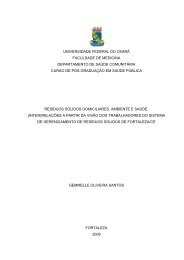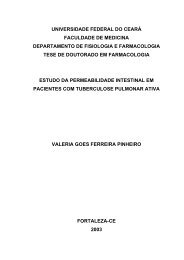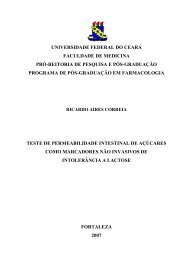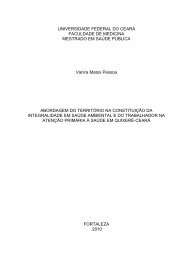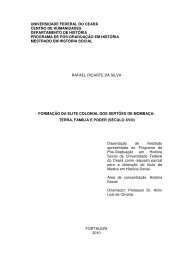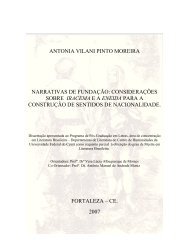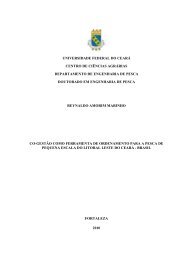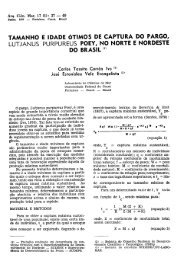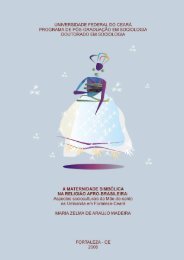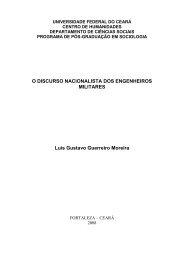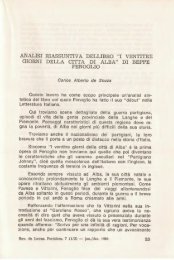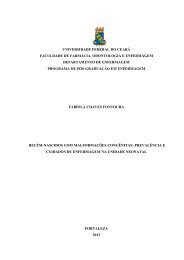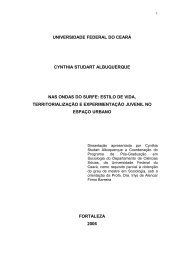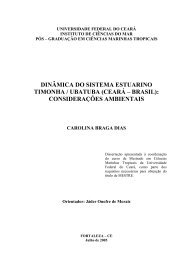Tungíase: doença negligenciada causando patologia grave
Tungíase: doença negligenciada causando patologia grave
Tungíase: doença negligenciada causando patologia grave
You also want an ePaper? Increase the reach of your titles
YUMPU automatically turns print PDFs into web optimized ePapers that Google loves.
Table 1. cont.<br />
Cats<br />
confirms further the notion of transmission indoors and also the<br />
need for in vitro studies on the effect of insecticides on pre-adult<br />
stages of T. penetrans.<br />
The adjusted odds ratios and the population attributable<br />
fractions found in our study were very high for some variables.<br />
Although we have done an observational study, the strength of<br />
Table 2. Multivariate logistic regression analysis of factors associated with tungiasis.<br />
association, together with the biological plausibility of the<br />
discussed variables, increases the likelihood that the identified<br />
factors in fact have a causal relationship with tungiasis, even in the<br />
presence of unknown confounders. The identification of a limited<br />
number of obviously important factors helps to focus intervention<br />
measures on only a few variables which can be modified easily and<br />
Adjusted OR (95% confidence interval) P value<br />
Presence of pigs on compound 17.98 (5.55–58.23) ,0.0001<br />
Floor of sand or clay inside the house 9.33 (5.06–17.19) ,0.0001<br />
Resting place outside house 7.14 (4.0–14.29) ,0.0001<br />
Being #14 years or $40 years 5.02 (1.84–13.70) 0.002<br />
Being illiterate/primary school not completed 4.16 (1.18–14.64) 0.026<br />
Presence of cats on compound 4.16 (1.73–10.02) 0.001<br />
Use of insecticides indoors 0.20 (0.05–0.83) 0.027<br />
Use of soap for bathing 0.25 (0.08–0.77) 0.016<br />
Use of water from well or tank 0.31 (0.16–0.59) ,0.0001<br />
Regular use of footwear 0.34 (0.18–0.62) ,0.0001<br />
doi:10.1371/journal.pntd.0000087.t002<br />
Examined n Positive n (%) OR (95% confidence interval) P value<br />
No 451 191 (42.4) Reference<br />
Yes 57 34 (59.7) 1.91 (1.05–3.50) 0.025<br />
No 500 218 (43.6) Reference<br />
Goats and/or chickens<br />
Yes 273 117 (42.9) 0.83 (0.58–1.17) 0.27<br />
No 284 135 (47.5) Reference<br />
Knowledge. attitudes and practices<br />
Knowledge on possible causes of tungiasis<br />
Sand/animals 416 141 (33.9) Reference<br />
Other/does not know 141 111 (78.7) 7.22 (4.51–11.73) ,0.0001<br />
Use of closed footwear<br />
Regularly 318 87 (27.3) Reference<br />
No/Occasionally 239 165 (69.0) 5.92 (4.03–8.71) ,0.0001<br />
Resting place<br />
Inside the house 299 60 (20.1) Reference<br />
Outside the house 258 192 (74.4) 11.58 (7.63–17.06) ,0.0001<br />
Use of soap for bathing<br />
Yes 496 203 (40.9) Reference<br />
No 61 49 (80.3) 5.89 (2.99–12.45) ,0.0001<br />
Type of prevention used<br />
Commercialized insecticides 53 5 (9.4) Reference<br />
Water/other/none 504 247 (49.0) 9.27 (3.59–30.10) ,0.0001<br />
Method of treatment used<br />
Treatment by paramedical personnel 85 14 (16.5) Reference<br />
Self-treatment* 326 203 (62.3) 8.36 (4.42–16.71) ,0.0001<br />
None 146 35 (24.0) 1.6 (0.77–3.45) 0.24<br />
* manipulation of lesions with non-sterile perforation instruments (such as needles. thorns). as well as application of hot oil. herbs etc.<br />
doi:10.1371/journal.pntd.0000087.t001<br />
Tungiasis in Nigeria<br />
PLoS Neglected Tropical Diseases | www.plosntds.org 6 2007 | Volume 1 | Issue 3 | e87



